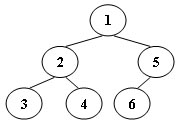An inorder binary tree traversal can be implemented in a non-recursive way with a stack. For example, suppose that when a 6-node binary tree (with the keys numbered from 1 to 6) is traversed, the stack operations are: push(1); push(2); push(3); pop(); pop(); push(4); pop(); pop(); push(5); push(6); pop(); pop(). Then a unique binary tree (shown in Figure 1) can be generated from this sequence of operations. Your task is to give the postorder traversal sequence of this tree.

Figure 1
Input Specification:
Each input file contains one test case. For each case, the first line contains a positive integer N (≤30) which is the total number of nodes in a tree (and hence the nodes are numbered from 1 to N). Then 2N lines follow, each describes a stack operation in the format: "Push X" where X is the index of the node being pushed onto the stack; or "Pop" meaning to pop one node from the stack.
Output Specification:
For each test case, print the postorder traversal sequence of the corresponding tree in one line. A solution is guaranteed to exist. All the numbers must be separated by exactly one space, and there must be no extra space at the end of the line.
Sample Input:
6
Push 1
Push 2
Push 3
Pop
Pop
Push 4
Pop
Pop
Push 5
Push 6
Pop
Pop
Sample Output:
3 4 2 6 5 1
题目的意思就是输入一颗二叉树的先序遍历和中西医遍历,让你输出后序遍历
Push操作的是先序遍历 Pop操作的是中序遍历
我们可以用一个堆栈来模拟输入的Push和Pop操作。 其中用到了c++中的strcmp函数
注意:strcmp函数只对char类型进行比较 所以,用 string str;cin>>str; 来接受输入的Push或者Pop在strcmp上是运行不过去的
就可以用char ch[5]; cin>>ch; 来进行字符串的输入
以下是代码
#include <bits/stdc++.h>
using namespace std;
struct node
{
int data;
// int layer; ///存放层数
node * left;
node * right;
};
node * root = new node;
int n;
int pre[100];
int in[100];
/// 返回的是root根节点的地址
node *CreatTree(int PL,int PR,int IL,int IR) ///由先序遍历和中序遍历创建一颗二叉树 方法用的是根据先序的左右子树
///范围和中序的左右子树的范围
{
if(PL>PR) ///说明孩子树已经不存在了
return NULL;
int k=0;
node* root=new node;
root->data=pre[PL];
for(k=IL; k<=IR; k++)
{
if(pre[PL] == in[k]) ///说明找到了根节点
break;
}
int numLeft=k-IL;
root->left=CreatTree(PL+1,PL+numLeft,IL,k-1); ///返回的是左子树的地址
root->right=CreatTree(PL+numLeft+1,PR,k+1,IR); ///返回的是右子树的地址
return root;
}
int cnt=0; ///cnt用来进行控制空格的输出
void postorder(node * root) ///后序遍历
{
if(root==NULL)
return ;
postorder(root->left);
postorder(root->right);
cout<<root->data;
if(cnt<n)
cout<<" ";
cnt++;
}
void f() ///题目上要求的输入
{
stack<int> st; ///用堆栈来对题目中的Push和Pop进行模拟
cin>>n;
int pk=0;
int ik=0;
for(int i=0; i<2*n; i++)
{
char str[5];
cin>>str;
if(strcmp(str,"Push")==0)
{
int num;
cin>>num;
st.push(num);
pre[pk++]=num;
}
else
{
in[ik++]=st.top();
st.pop();
}
}
}
int main()
{
f();
root=CreatTree(0,n-1,0,n-1);
postorder(root);
return 0;
}